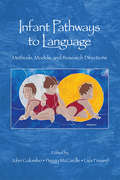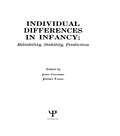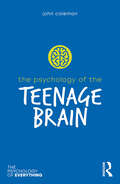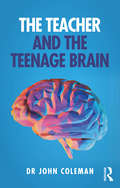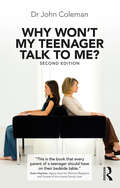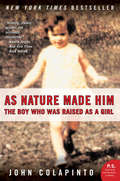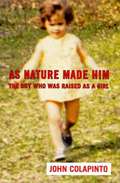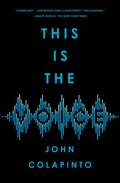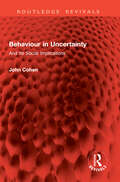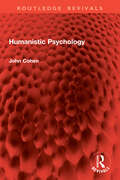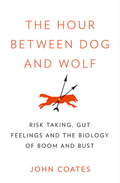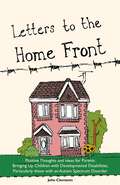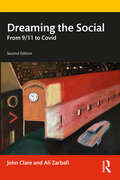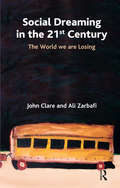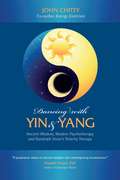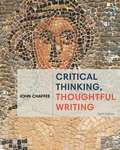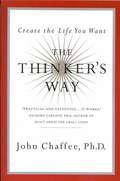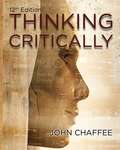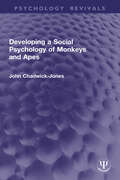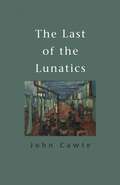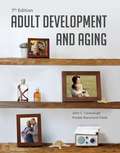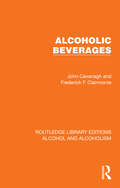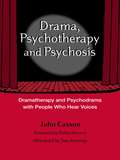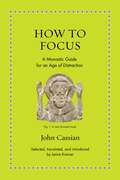- Table View
- List View
Infant Pathways to Language: Methods, Models, and Research Directions
by John Colombo Peggy McCardle Lisa FreundThe recent progress in cognitive neuroscience, and the importance of genetic factors and gene-environment interactions in shaping behavioral functions in early childhood, have both underscored the primacy of early experience and development on brain development and function.The contributors to this volume discuss different paradigms and approaches
individual Differences in infancy: Reliability, Stability, and Prediction
by John Colombo Jeffrey FagenThe papers presented in this volume, written by active and well- known researchers, discuss experimental research that has validated the importance of infancy in individual development over the age continuum. In addition, a diverse overview section contains informative chapters on conceptual models for individual differences during infancy including: individual differences from the perspective of dynamical systems theory the logic of behavioral genetic designs and their use in the delineation of genetic contributions to individual differences coverage of basic statistical treatments for individual difference data focussing on cluster analytic techniques
The Psychology of the Teenage Brain (The Psychology of Everything)
by John ColemanWhy do teenagers stay up late and struggle to get up in the morning? Do teenagers really take more risks? What is happening with teenagers’ hormones? The Psychology of the Teenage Brain offers all those involved in teenagers’ lives insight into what’s happening in their brains and how understanding them can improve relationships and communication at this crucial stage. It explains key topics, including the way the brain changes during adolescence, the role of hormones, and what we really know about risk and resilience, sleep and peer pressure. It challenges the stereotype of the ''snowflake generation'' and explores young people’s mental health. Written for all parents and caregivers, this book will help with the challenges of having a teenager in the home. It also offers crucial understanding for all students and practising professionals in the fields of social work, counselling, health and education who work with teenagers.
The Teacher and the Teenage Brain
by John ColemanThe Teacher and the Teenage Brain is essential reading for all teachers and students of education. This book offers a fascinating introduction to teenage brain development and shows how this knowledge has changed the way we understand young people. It provides a critical insight into strategies for improving relationships in the classroom and helping both adults and teenagers cope better with this stage of life. Dr John Coleman shows how teachers and students can contribute to healthy brain development. The book includes information about memory and learning, as well as guidance on motivation and the management of stress. Underpinned by his extensive work with schools, Dr Coleman offers advice on key topics including the importance of sleep, the social brain, moodiness, risk and risk-taking and the role of hormones. This book is extensively illustrated with examples from classrooms and interviews with teachers. It explicitly links research and practice to create a comprehensive, accessible guide to new knowledge about teenage brain development and its importance for education. Accompanied by a website providing resources for running workshops with teachers and parents, as well as an outline of a lesson plan for students, The Teacher and the Teenage Brain offers an innovative approach to the understanding of the teenage brain. This book represents an important contribution to teacher training and to the enhancement of learning in the classroom.
Why Won't My Teenager Talk to Me?
by John ColemanDo you wish your son or daughter would tell you more about what is happening in their life, and that they would open up to you more often? Are you worried about them as they seem to be spending more and more time in their bedroom and on their smart phone? The teenage years can be a time of concern and worry for parents and carers from all backgrounds. However, Why Won’t My Teenager Talk to Me? offers the parent and care-giver insightful and practical advice, as to how to encourage positive and respectful two-way communication between you and your teenager. The new edition of this essential book offers a positive way of thinking about the teenage years. So much has changed in the last five years since the book first appeared. Our knowledge of the human brain has increased, and this new edition includes a whole chapter devoted to the changing teenage brain. The social world of the teenager has also continued to change. Alongside the voices of a wide range of parents and carers of teenagers, Dr John Coleman explores this changing social landscape, addressing issues like social media, mental health, and gender. Communication is really at the heart of Dr John Coleman’s message – talking and listening are essential – and this book offers up new and valuable ways in which communication can help the parent and care-giver manage family life during the adolescent stage of life. It will also be useful to professionals working with young people in the fields of social work, counselling, health, and education.
As Nature Made Him
by John Colapinto<P>In 1967, after a baby boy suffered a botched circumcision, his family agreed to a radical treatment. <P> On the advice of a renowned expert in gender identity and sexual reassignment at Johns Hopkins Hospital, the boy was surgically altered to live as a girl. This landmark case, initially reported to be a complete success, seemed all the more remarkable since the child had been born an identical twin: his uninjured brother, raised as a boy, provided to the experiment the perfect matched control. <P>The so-called twins case would become one of the most famous in modern medicine and the social sciences; cited repeatedly over the past thirty years as living proof that our sense of being male or female is not inborn but primarily the result of how we are raised. <P>The case was a failure from the outset because the twin struggled against his imposed girlhood. At fourteen, when told of his medical history, he made the decision to live as a male. <P>John Colapinto tells this extraordinary story for the first time in As Nature Made Him. The human intimacy of the story is all the greater for the subject's courageous decision to step out from behind the pseudonym that has shrouded his identity for the past thirty years.
As Nature Made Him: The Boy Who Was Raised as a Girl
by John ColapintoBrian and Bruce Reimer were born as normal identical twin boys. At 8 months of age, they developed a urinary problem, which their Winnipeg hospital said could be easily cured via circumcision. The day they were scheduled for that, a doctor who did not normally do this procedure was in charge. As a result, Bruce lost his penis altogether. Dr. John Money of Johns Hopkins Hospital, who had been treating intersexed babies by genital surgery, saw this as the perfect empirical study of nurture over nature. These were developmentally-normal identical twin boys. Following this, Bruce was castrated, his name changed to Brenda and he was raised as a girl. However, Brenda's personality did not conform, no matter how much the family and others tried to nurture the child as a girl. Neither twin was told of their background. In their early teens, Brenda rebelled. Eventually, she was told the truth and felt "normal", she was indeed the boy she had always felt internally. She changed her name to David, as one who slew the incomparably-sized Goliath. The rest of the book tells how David's life developed from there forward to adulthood, marriage, and fatherhood. It also covers Dr. Money's cover-up of the study results as not the positive picture he had reported consistently over the years, and details his downfall in the medical profession. Of note, is that the study, which was reported as successful nurture over nature, was constantly used in feminist rhetoric at the time about gender roles. Money was also an early co-founder of the Gender Identity Clinic at Johns Hopkins, involved with transsexual procedures. The author began this investigation for a Rolling Stone magazine article. Later, David Reimer decided to let his story become public for the education of others, and asked Colapinto to do the writing. There are three vulgar sex terms, minor description of pornographic pictures used by the doctor, and a few uses of the word "God."
This Is the Voice
by John ColapintoA New York Times bestselling writer explores what our unique sonic signature reveals about our species, our culture, and each one of us. Finally, a vital topic that has never had its own book gets its due.There&’s no shortage of books about public speaking or language or song. But until now, there has been no book about the miracle that underlies them all—the human voice itself. And there are few writers who could take on this surprisingly vast topic with more artistry and expertise than John Colapinto. Beginning with the novel—and compelling—argument that our ability to speak is what made us the planet&’s dominant species, he guides us from the voice&’s beginnings in lungfish millions of years ago to its culmination in the talent of Pavoratti, Martin Luther King Jr., and Beyoncé—and each of us, every day. Along the way, he shows us why the voice is the most efficient, effective means of communication ever devised: it works in all directions, in all weathers, even in the dark, and it can be calibrated to reach one other person or thousands. He reveals why speech is the single most complex and intricate activity humans can perform. He travels up the Amazon to meet the Piraha, a reclusive tribe whose singular language, more musical than any other, can help us hear how melodic principles underpin every word we utter. He heads up to Harvard to see how professional voices are helped and healed, and he ventures out on the campaign trail to see how demagogues wield their voices as weapons. As far-reaching as this book is, much of the delight of reading it lies in how intimate it feels. Everything Colapinto tells us can be tested by our own lungs and mouths and ears and brains. He shows us that, for those who pay attention, the voice is an eloquent means of communicating not only what the speaker means, but also their mood, sexual preference, age, income, even psychological and physical illness. It overstates the case only slightly to say that anyone who talks, or sings, or listens will find a rich trove of thrills in This Is the Voice.
Behaviour in Uncertainty: And Its Social Implications (Routledge Revivals)
by John CohenFirst published in 1964, Behaviour in Uncertainty begins with an analysis of the manner in which we weigh evidence or commit ourselves to a course of action. From here it is but a step of choices when life and limb are at stake, as in the behaviour of motorists and pedestrians on the road, or when suicide is contemplated, alone or with a loved one. In all these situations, as in acrobatics or on the playing field, there are elements of risk and hazard, and in all of them the individual may suffer from one of many diseases of decision making.These variations on the theme of behaviour in uncertainty are traced by the author in experimental predicaments, in adventures of the imagination, in moments of crisis, and in the confrontation with death. All this jumps to life historically when viewed against the background of divinatory practices through the ages. These universal practices demonstrate man's never-ending efforts to conquer the uncertainties that desert him and, in particular, to wrest the secrets which the future has in store. This is an interesting read for students of psychology.
Humanistic Psychology (Routledge Revivals)
by John CohenFirst published in 1958, Humanistic Psychology opens with a consideration of the many different ways in which a system of psychology can be built. Professor Cohen takes an entirely different view from that which suggests that a knowledge of the brain will eventually tell us all we need to know about the mind. The qualities of human experience are peculiar to themselves and cannot be reduced only to the activities of the central nervous system.Psychology, it is then suggested, must begin with the meaning of experience from the ‘inside’. This meaning can be deciphered only in terms of the past which has shaped our minds and of the future which we envisage as beckoning us. Four fundamental themes are chosen to illustrate this conception of psychology: first, the successive stages of emotional and social maturation through which every normal child passes between birth and puberty; second, the personal and social significance of sensory experience; third, the individuality of thought and its social qualities. The fourth theme embraces three topics of more general interest- work and play, illness, and literature.Humanistic Psychology is intended to be an introductory text for the general reader as well As for professional students of psychology, psychiatry, philosophy and the social sciences.
The Hour Between Dog and Wolf
by John CoatesA successful Wall Street trader turned Cambridge neuroscientist reveals the biology of financial boom and bust, showing how risk-taking transforms our body chemistry, driving us to extremes of euphoria or stressed-out depression. The laws of financial boom and bust, it turns out, have a lot to do with male hormones. In a series of startling experiments, Canadian scientist Dr. John Coates identified a feedback loop between testosterone and success that dramatically lowers the fear of risk in men, especially young men; he has vividly dubbed the moment when traders transform into exuberant high flyers "the hour between dog and wolf." Similarly, intense failure leads to a rise in levels of cortisol, which dramatically lowers the appetite for risk. His book expands on his seminal research to offer lessons from the exploding new field studying the biology of risk. Coates's conclusions shed light on all types of high-pressure decision-making, from the sports field to the battlefield, and leaves us with a powerful recognition: to handle risk isn't a matter of mind over body, it's a matter of mind and body working together. We all have it in us to be transformed from dog to wolf; the only question is whether we can understand the causes and the consequences.
Letters to the Home Front: Positive Thoughts and Ideas for Parents Bringing Up Children with Developmental Disabilities, Particularly those with an Autism Spectrum Disorder
by John ClementsBringing up a child with developmental disabilities, especially autism, presents many challenges for parents, and the focus of attention is almost invariably on the child. This practical and compassionate book looks at a range of issues from the parents' point of view - from whether their child really loves them, to challenging received wisdom on matters such as sensory integration and boarding school. The author's many decades of experience of working with families provide the basis for this practical support and help in thinking about and approaching some of the most difficult and intractable issues. One, often unvoiced, concern for parents is whether their children love or care about them. The first section of the book consists of three letters from young people to their parents, showing clearly that though they may never have been able to say so directly, they do love and appreciate their parents, and what they have done for them - a strong message for all parents in a similar situation. Clements goes on to look at how the parenting agenda changes over time, how to see beyond the diagnoses and the constant need to deal with immediate problems, to see the real people who make up the family, the impact on siblings, how to manage the system and the multiple professional agencies over long periods of time, and how to think about the offer of medication to control behaviour. An important section addresses some of the most distressing behavioural challenges: physical aggression, verbal abuse, long-term severe self-injury, property damage, and obsessions. Finally, Clements offers objective and open-minded reflections on received wisdom about two other unchallenged topics - sensory integration, and the usefulness or otherwise of boarding schools. The book is practical, compassionate, and above all, useful. It will be of ongoing use to parents, and equally useful to professionals working with families encountering the issues covered.
Dreaming the Social: From 9/11 to Covid
by John Clare Ali ZarbafiDreaming the Social uses social dreaming as a tool to explore aspects of contemporary life and examine how we can reverse social fragmentation and large-scale trauma. Since the attack on New York on 9/11, the world has been balanced on the edge of potential disaster, exacerbated in recent years by global warming, the Covid pandemic, and war in Ukraine. Since the first edition in 2009, these national and global events have come to dominate our lives in unforeseen ways. With this in mind, this new edition explores the potential of social dreaming to help access things we know but are unable to think, except through the complex activity of dreaming. Based on several research studies, group sessions, and mass dreaming experiments, the book explores peoples’ experiences of dreaming during times of change, transition, and upheaval and discusses the insights that these dreams offer. Dreaming the Social will be of great interest to all professionals interested in dreams and the power of social dreaming, including psychoanalysts, psychotherapists, and clinical psychologists.
Social Dreaming in the 21st Century: The World We Are Losing
by John Clare Ali ZarbafiWe are running out of ideas in Western society. Faced with global warming, Third World devastation, nuclear proliferation and the threat posed by religious conflict, we need new ways of thinking. After the loss and carnage of the Twentieth Century there is prevailing mood of uncertainty and paranoia, yet at the same time a denial of tragedy, a salvation fantasy, an illusion that we will be saved. The decline in social solidarity, the fragmentation of communal values and a growing sense of 'I' as opposed to 'we', are all signs of an inversion of moral certitudes, a disconnection from reality. This book asks what methods do we have at our disposal to understand and reverse this breakdown of communication within and between communities.
Dancing with Yin and Yang: Ancient Wisdom, Modern Psychotherapy and Randolph Stone's Polarity Therapy
by John ChittyThis new approach to mental wellness shows how the universal principles of nature, known as Yin and Yang in the wisdom traditions, can be applied to psychology. General principles and specific applications are provided, including a fresh view of Fritz Perls' famous two-chair Gestalt method and a concise illustrated summary of Stephen Porges' Polyvagal Theory.
Critical Thinking, Thoughtful Writing, 6th Edition
by John ChaffeeEmphasizing that thinking well and writing well are invariably connected, CRITICAL THINKING, THOUGHTFUL WRITING, 6e delivers thorough coverage of the writing process, going beyond the traditional rhetoric to teach you how to evaluate sources, images, and arguments. This rhetoric with readings introduces the process of thinking critically as a powerful approach to writing, to critically evaluating electronic and visual media, and to life in general. Each chapter focuses on a critical-thinking skill--such as problem solving or analysis of complex issues--that is explored through Thinking-Writing Activities and thematically linked readings. Each of the readings challenges you to read actively, think critically, and then write about the readings. The Sixth Edition offers provocative new readings, a four-color interior design, expanded writing projects that help you fully interact with the writing process, annotations to student essays, and more in-chapter questions to help you reflect on the material.
The Thinker's Way: 8 Steps to a Richer Life
by John ChaffeeYour life is a work of art that you create. Make yours a masterpiece. Filled with examples and exercises, you can keep sight of your goals, make good decisions and create the life you want.
Thinking Critically
by John ChaffeeTHINKING CRITICALLY helps students become sophisticated thinkers by teaching the fundamental cognitive process that allows them to develop the higher-order thinking abilities needed for academic study and career success. The text compels students to use their intellect to think critically about subjects drawn from academic disciplines, contemporary issues, and their life experiences. The text begins with basic skills related to personal experience and then carefully progresses to the more sophisticated reasoning skills required for abstract, academic contexts. Each chapter provides an overview of an aspect of critical thinking, such as problem-solving, perception, and the nature of beliefs. Thinking Activities, thematic boxes, and writing assignments encourage active participation and prompt students to critically examine others' thinking, as well as their own. Thought-provoking and current readings from a wide variety of thinkers get students to think about complex issues from different perspectives. Each chapter ends with self-assessment activities that help students monitor their own progress as critical thinkers.
Thinking Critically
by John ChaffeeBecome a more sophisticated thinker with THINKING CRITICALLY, which teaches you a surefire process for developing the thinking abilities you need for academic and career success. First, you'll build your confidence by learning and practicing basic skills related to your personal experiences. Next, you'll progress to the types of reasoning skills required for abstract contexts -- such as your academic courses. Activities and writing assignments invite your active participation and prompt you and your peers to critically examine each other's thinking. Thought-provoking and current readings from a wide variety of thinkers engage you in thinking about complex issues from different perspectives. Along the way, monitor your own progress as a critical thinker with self-assessment activities.
Developing a Social Psychology of Monkeys and Apes (Psychology Revivals)
by John Chadwick-JonesOriginally published in 1998, the aim of Developing a Social Psychology of Monkeys and Apes was to draw attention to the exciting progress of studies of the social psychology of monkeys and apes happening at the time. It is written with a clear style which should invite interest from a wide range of social scientists. The relatedness of humans and non-human primates that was usually considered in its genetic forms is followed through into the complex social tactics of monkeys and apes. The focus of the book was on the latest research as it had developed out of earlier classic studies. The wave of researchers working on social topics at the time is especially emphasized.This book will be of particular interest to primatologists, ethologists, anthropologists, zoologists, social psychologists, and students of social cognition and social interaction. For students, the appendices provide useful information on the variety of social structures of Old World and New World monkeys and apes.
Last Of The Lunatics
by John CawteJohn Cawte looks back in amazement to his years as a young doctor in an Australian madhouse. He now recognises the people he treated in the early 1950s as 'the last of the lunatics'. Anti-psychotic and anti-depressant drugs were unknown. Bursting asylums, housing an uproar of insanity, were wastelands of stigma and dread. 'Management' techniques ranged from straitjackets and padded cells to isolation and primitive shock treatments. Miraculously, Cawte's case notes were saved from destruction. Rereading them after forty years, he was gripped by the horror they revealed and the questions they raised. Much has changed for the better. Many of the fearful illnesses he recorded have disappeared, treatments are vastly more effective and stigma has lessened. But his notes hold a surprising and challenging lesson—that temporary 'asylum' from the stresses of life is often all that a disturbed person needs for recovery. The Last of the Lunatics is rich and moving. The personal stories recorded by a perceptive young man have been filtered by experience and sharpened by telling literary references. Doctors, psychiatrists, those who remember and those who wonder about the human condition will be touched by this compassionate book.
Adult Development And Aging
by Fredda Blanchard-Fields John CavanaughWritten within a bio-psychosocial framework, Cavanaugh and Blanchard-Fields' best-selling book covers the specific ages-stages of adult development and aging. In its unparalleled coverage of current research and theory, the authors draw clear connections between research and application. The book's focus on "positive aging" and the gains and losses people experience across adulthood distinguish it from its competitors.
Alcoholic Beverages (Routledge Library Editions: Alcohol and Alcoholism)
by John Cavanagh Frederick F. ClairmonteFor most of the post-war period, alcohol problems had been viewed primarily as individual problems. During the 1970s and 1980s, research highlighted the importance of larger socio-economic factors in shaping drinking levels, patterns and problems. However, it largely ignored a paramount force which shaped this larger socio-economic environment: the modern multinational corporation. The aim of this book, originally published in 1985, was to demonstrate, on the basis of historical analysis, that transnational corporate structures and marketing strategies exercised a powerful impact on the availability and consumption of alcoholic beverages in both developed and developing marketing economies. While the authors did not want to suggest a single causal relationship between corporate strategies and the consumption of alcoholic beverages, the implications of their work were of the greatest significance to public health throughout the world. The book was an indispensable work for those interested in public health, alcoholism, and multinational business at the time. Today it can be read in its historical context.
Drama, Psychotherapy and Psychosis: Dramatherapy and Psychodrama with People Who Hear Voices
by John CassonJohn Casson - Winner of the British Psychodrama Association (BPA) Lifetime Achievement Award 2012! Drama, Psychotherapy and Psychosis explores the use of drama and theatre in the challenging area of working with people who hear voices, focusing especially on survivors of abuse and those diagnosed as suffering from schizophrenia. In examining the often baffling and frightening world of psychosis the book offers alternative models of madness and the self, which form the basis for therapeutic interventions. Illustrated by case histories and examples of practice, this book provides a description and analysis of voice hearing. Chapters cover areas including:* historical perspectives on psychosis and hearing voices * group psychodrama * dramatherapy with individuals.Drama, Psychotherapy and Psychosis demonstrates how creative action methods can be helpful to those who hear voices. It provides guidelines for good practice; essential to all those interested in promoting the safe use of these methods in therapy.
How to Focus: A Monastic Guide for an Age of Distraction (Ancient Wisdom for Modern Readers)
by John CassianHow you can learn to focus like a monk without living like oneDistraction isn’t a new problem. We’re also not the first to complain about how hard it is to concentrate. Early Christian monks beat us to it. They had given up everything to focus on God, yet they still struggled to keep the demons of distraction at bay. But rather than surrender to the meandering of their minds, they developed powerful strategies to improve their attention and engagement. How to Focus is an inviting collection of their strikingly relatable insights and advice—frank, funny, sympathetic, and psychologically sophisticated.This wisdom is drawn from John Cassian’s fifth-century CE Collationes, one of the most influential manuals for monks from late antiquity. The Collationes follow Cassian and his friend Germanus as they travel around Egypt, asking a series of sage monks how they can make their minds stronger. In response, these monks offer a range of techniques for increasing focus, including setting goals, training the body, managing the memory, using mantras, taking breaks, consulting others—and, most of all, being honest about yourself. As Cassian and Germanus eventually realize, we can’t escape distraction—but we can learn how to confront it and, eventually, to concentrate.Featuring an engaging new translation by Jamie Kreiner and the original Latin on facing pages, How to Focus can help even the least monkish of us to train our attention on what matters most.
